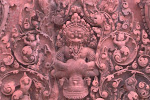| Dim sum, in a variety of styles, tempt the palate | | |
| Written by Stephanie Mee | |||
| Thursday, 21 May 2009 The Phnom Penh Post | |||
| Phnom Penh’s numerous Chinese restaurants bring the flavours of southern China to the capital with both traditional and innovative dishes Photo by: Tracey Shelton Selection of dim sum at Almond Hotel’s Yi Sang Chinese Restaurant. Dim Sum menu guide
Whatever image comes to mind, one thing is for certain: Phnom Penh's huge Chinese population means that tasty dim sum is usually only a stone's throw away. Originating in Southern China, the term dim sum translates literally to "touch heart", a metaphor for small plates of food meant to re-energise travellers on the old Silk Road. Today, dim sum has become synonymous with Chinese brunch, or Asian tapas, a culinary tradition that centres on small plates of tasty Southern Chinese fare, shared with friends or family, and washed down with plenty of Chinese tea. Sok Mean, the Cambodian-Chinese owner of Mekong Village Restaurant, says that dim sum are traditionally served at breakfast. "I get many Chinese and Cambodian customers who come here in the morning between 6am and 1pm to eat Hong Kong-style dim sum. Some people also order it for lunch or dinner, along with other dishes such as rice or soup." Mekong Village employs authentic Chinese chefs to cook up dim sum favourites such as siew mai - delicately spiced, ground pork wrapped in yellow dumpling wrappers, steamed, topped with a whole shrimp and garnished with orange fish roe. Another popular dim sum mainstay at Mekong Village are leek dumplings - thin, translucent rice papers bursting with finely chopped leeks and spring onions, fragrant minced garlic and earthy brown mushrooms, steamed and served hot. "My wife and I eat dim sum every day and we like the classic dim sum dishes, but we also like to experiment with new styles," said Sok Mean. Unique innovations at Mekong Village include rabbit and goldfish dumplings, a twist on the popular dim sum dish har gao. Conventional har gao is made out of ground pork or shrimp, wrapped in a transparent rice paper and steamed. "Dim Sum dishes can also be sweet rather than savoury," said Sok Mean. "For example, sweet egg custard tarts in the Macau style and taro paste buns are very popular as dim sum dishes as well." Dishes at Mekong Village range from US$1.50 to US$3 a plate, and come with complimentary pickled cucumber, and sides of garlic, chilli and soy sauce. An a la carte menu of Chinese specialities such as Peking duck and tripe is also available daily. Yi Sang Chinese Restaurant also offers dim sum daily in their elegant aquarium-lined dining room in the Almond Hotel. Dishes at Yi Sang include rice rolls - thick sheets of rice noodles, filled with barbecued pork and cilantro, steamed and covered in sweet soy sauce, as well as deep-fried Cantonese shrimp balls, and savoury, minced shrimp and pork dumplings. Guangzhou style "Our dim sum cuisine is mainly Guangzhou style, from Guangdong province," said Tit Vy, manager of Yi Sang restaurant. "This is why our menu contains a lot of traditional Chinese dishes like har gao, shrimp toast and, of course, fried chicken feet, which are very popular with Chinese and Khmer customers," he said. ...people like dim sum because the dishes are small, light and inexpensive... With his team of Guangdong province chefs, Tit Vy also creates six new dim sum creations each week. "Our regular dim sum menu and specials are well liked by all sorts of people; Chinese, Khmer and especially on weekends we get a lot of Western clientele who come to enjoy a relaxing brunch and great food," he said. At US$2.50 a plate, the dishes at Yi Sang are served with sides of spicy chilli oil, chilli sauce, complimentary tea and a small dessert. Sam Doo is another popular dim sum haunt, offering 18 fried and steamed delicacies on its special dim sum menu. Dishes at the busy two-level restaurant include char siu bao, fluffy steamed white buns filled with tangy Cantonese barbecue pork; fun co, steamed dumplings filled with pork, shrimp, peanuts and mushrooms; and deep fried sesame rolls to name a few. The menu also includes classic Cantonese fried meat and vegetable dishes and tasty soups. All dim sum meals are served with bottomless Chinese tea, and are good value at US$1.50 a plate. "I think people like dim sum because the dishes are small, light and inexpensive, and they can be shared," said Sok Mean. "This is the real Chinese way to eat fresh and delicious dim sum, together with family and friends." | |||


No comments:
Post a Comment